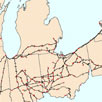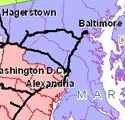Views
Views are short interpretive historical presentations from materials in the Railroads collection. Each View is aimed a research question or problem and assembles information from multiple sources: documents, lists, records, orginal maps, and other historical sources. Rather than using traditional footnotes or citations, these Views contain direct links and references to relevant sources used in their assembly. Views are "assemblages" of data and interpretation and should be considered multimedia experiments in the presentation of digital history.

Railroad Network Expansion in the United States
Railroads expanded across the United States in bursts of construction and consolidation. A "network" often did not exist, as lines failed to join one another at stations and competitive privileges of rival companies thwarted unification at key points. Yet, the railroad's spatial development in the U.S. placed localities on an ever-shifting map. Over time a locality's position might change in relationship to others, and over time network effects characterized the process of railroad growth and change. An event at one point affected other places.

Northern Expansion in the 1850s
The Illinois Central Railroad received the first federal land grant in September 1850. The area comprised some 2,595,000 acres in Illinois. The railroad opened the lands for sale in 1852 and began a sophisticated land marketing and promotion operation to attract settlers onto the prairies. The Land Department advertised in Europe, printed detailed brochures explaining how lands could be bought with ten-year mortgages, and provided excursion rates for land settlers to travel west and see the lands for themselves. The rapidity of the sales fueled extraordinary growth of towns along the line. Northern railroad expansion in the Midwest matched Southern railroad growth in the 1850s. Both sections understood their development in sectionalized terms.

Network Connectivity--A Close Analysis of the Baltimore and Ohio Railroad's Expansion
The Baltimore and Ohio Railroad was the first railroad to break through the Allegheny Mountains and reach the Ohio River. The route to the Ohio was completed in1857, but throughout the nineteenth century the company acquired other railroads, expanded its operations, and reconstituted its system. This view explores the dynamic expansion and contraction inherent in these systems. Rather than a uniform process of growth, railroads underwent spatially uneven and disjointed development over long periods of time. By Richard G. Healey and William G. Thomas.

Violence and Expansion on the Great Plains
As railroads expanded across the Great Plains West, white settlement also spread through the region, encroaching upon Native American lands. Conflict among settlers, and between whites and Native peoples followed. Andrew Graybill and William G. Thomas compare violence and expansion on the Great Plains with the U. S. South, focusing especially on the Marias Massacre in Montana.

Map Inaccuracies in Railroad Sources
Developing a Historical Geographic Information System (H-GIS) for railroads in the United States reveals numerous inaccuracies in historical railroad atlases and maps. In this case study we examine some of the problems we faced in developing and integrating rail GIS from the University of Nebraska and the University of Portsmouth.